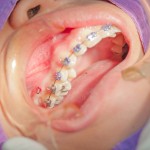
Temporary anchorage devices (TADs) are now in common use for reinforcing orthodontic anchorage being simple to insert with a low failure rate. There are two main categories of TADs osseointegrated mini-implants and the mini-screws.
Mini-screws are smaller designed for immediate loading rand rely primarily on mechanical stability while palatal implants are larger in diameter requiring surgical placement a healing and removal and time for osseointegration although recent studies suggest they can be immediately loaded.
The aim of this review was to provide a comprehensive update of the literature on the failure rates of palatal implants and palatal mini-screws, used for supplementing anchorage during orthodontic treatment.
Methods
The Medline, Embase, the Cochrane Oral Health Group’s Trials Register, and CENTRAL. ClinicalTrials.gov, the National Research Register, and Pro-Quest Dissertation Abstracts and Thesis databases were searched. Randomised controlled trials (RCTs) non-randomised, or quasi-randomised controlled trials, prospective, and retrospective studies involving the assessment of success or failure of palatal implants or palatal mini-screws for orthodontic anchorage reinforcement were considered.
Two reviewers independently selected the studies, extracted data and assessed risk of bias. Prospective and retrospective studies were graded as low, unclear, or high risk of bias according to criteria, adapted from the Bondemark scoring system.
Results
- 27 studies (4 RCTs, 12 prospective, 11 retrospective) were included
- All 4 RCTS and 2 prospective studies were considered to be at low risk of bias.
- 3 prospective studies and 5 retrospective studies were considered to be at high risk of bias, the reminding studies were at unclear risk.
- Only one retrospective study evaluated and reported both on palatal implants and mini-screws, among other TAD designs. All other included studies assessed, exclusively, either palatal implants or mini-screws
- The number of palatal implants or mini-screws per study ranged from 9 to 384.
- Follow up periods ranged from 2 – 35.6 months. (median = 17.9).
- 18 studies assessed risk of failure for palatal implants which ranged from 0.0 – 26.1% (median 6.0%)
| No of studies | Risk of failure (median) | |
| RCTs | 4 | 2.5 -26.1% (8.8%) |
| Prospective studies | 7 | 0.0 -14.3% (7.7%) |
| Retrospective studies | 7 | 0.0 -21.4% (5.0%) |
- 10 studies assessed risk of failure for mini-screws, risk of failure ranged from 0.0 – 33.3% (median 6.1%).
- No RCTs assessed mini-screws, the risk of failure in the prospective studies (n = 5) ranged from 0.0 – 33.3 % and 2.1 -16.7% in the retrospective studies (n = 5).
Conclusions
The authors concluded: –
This review provides updated information on the failure risk of palatal implants and mini-screws used for orthodontic anchorage. Both palatal implants and mini-screws have quite low failure rates that are comparable, and thus their value as orthodontic anchorage means is not questionable. Based on the available evidence, no clinically meaningful difference in failure risk seems to exist between palatal implants and mini-screws, though the median follow-up period of palatal implants was quite larger. Therefore, in regular orthodontic cases, the choice between anchoring devices may rely on other factors, such as costs, patient comfort, personal preferences, familiarity with the device and insertion procedures.
Comments
The reviewers have undertaken and extensive search for studies however only one study provided a direct comparison between the palatal implants and mini-screws. The reviewers also highlighted that there was considerable heterogeneity between the studies in relation to sample size, age and sex as well as potential issues with clustering effects because of multiple TAD use in patients.
Both palatal implants and mini-screws had a median failure rate of 6% although considerable variation was seen across the studies although the palatal implants studies had a longer average follow-up period. The most common definition of failure was that implant or screw displayed mobility although several studies report on failure before loading and there is some discussion to be had about whether these were counted as failures.
This review suggests that there may be little difference in failure rates between these two major types of TAD. However, the available studies are not of high quality so better reporting of future studies in this area would be helpful. For many the reactive ease of placement of mini-screws, albeit with the potential to damage anatomical structures compared with the need for surgical placement and removal of palatal implants will seem advantageous.
Links
Primary Paper
Kakali L, Alharbi M, Pandis N, Gkantidis N, Kloukos D. Success of palatal implants or mini-screws placed median or paramedian for the reinforcement of anchorage during orthodontic treatment: a systematic review. Eur J Orthod. 2018 Mar 28. doi: 10.1093/ejo/cjy015. [Epub ahead of print] PubMed PMID: 29608666.
Other references
Dental Elf – 4th May 2017
